The cerebellum may be small, but it plays a significant role in moving, balancing, and coordinating our actions. When this vital part of the brain is damaged, simple tasks like walking or speaking can become challenging. Whether caused by injury, illness, or neurological conditions, cerebellar brain damage can significantly impact a person’s daily life.
In this blog, we’ll discuss the common causes of cerebellum damage, the symptoms to watch for, and, most importantly, how rehabilitation can help individuals regain control, rebuild strength, and reclaim independence.
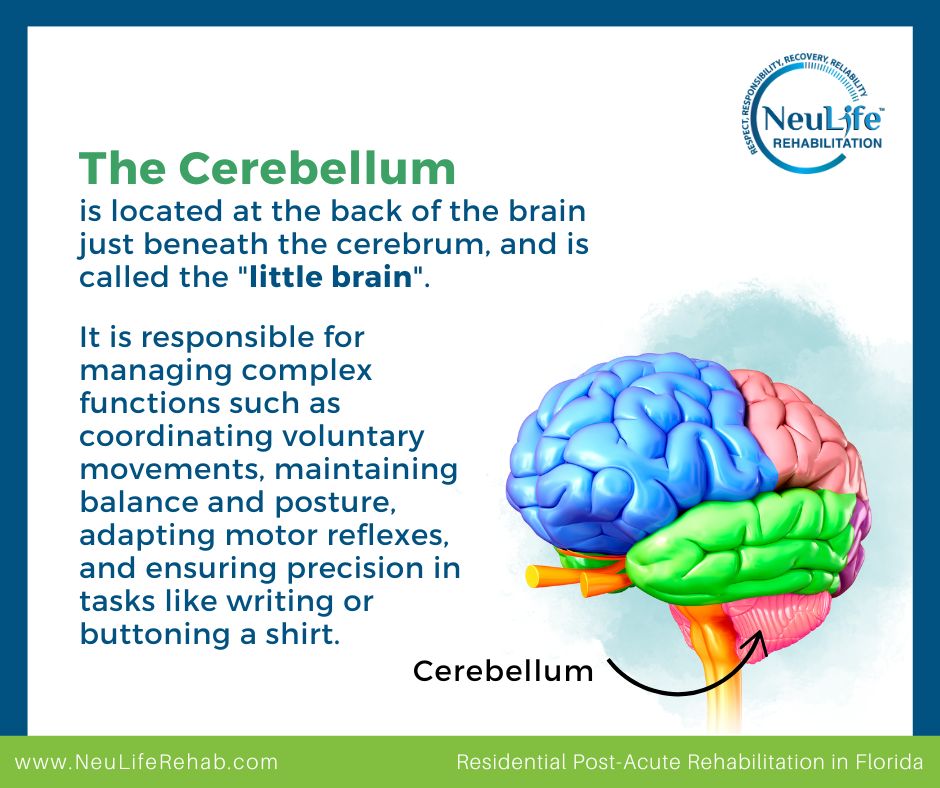
The cerebellum, located at the back of the brain just beneath the cerebrum, is Latin for "little brain"—but don’t let the name fool you. It handles complex tasks essential to moving smoothly and reacting appropriately to our environment. This includes:
Traumatic Brain Injury (TBI) can impact different areas of the brain, with effects varying based on injury location and severity. Commonly affected regions include the cerebrum (which governs cognitive functions, motor skills, and emotions), the cerebellum (responsible for balance and coordination), and the brainstem (which controls vital functions like breathing and heart rate). TBI can result in physical, cognitive, and emotional changes, so early diagnosis and treatment are essential for optimal recovery.
To learn more, read our blog on “What Parts of the Brain Are Impacted by TBI?”
The importance of understanding cerebellum damage goes beyond the surface—here’s what you should know:
Recognizing the signs of cerebellum damage, such as unsteady movement (ataxia), slurred speech, difficulty with coordination, or balance issues, can lead to quicker diagnosis and intervention. The earlier the damage is addressed, the more effective rehabilitation tends to be.
Because the cerebellum doesn’t control cognition or speech like the cerebrum, its damage might not always be immediately recognized. Misdiagnoses or delays in treatment can worsen the long-term impact. Awareness helps ensure that this critical part of the brain isn’t ignored.
While cerebellum damage primarily affects motor control, it can also lead to subtle cognitive and emotional changes, such as difficulty with planning, memory, or emotional regulation. This condition, called Cerebellar Cognitive Affective Syndrome (CCAS), is still being actively researched and is often missed in clinical evaluations.
Understanding the nature of cerebellum damage helps shape effective rehabilitation programs. For example:
Knowledge reduces fear. When patients and caregivers understand cerebellum brain damage, they’re better prepared to manage symptoms, engage in therapy, and make informed care decisions. It fosters realistic expectations and promotes proactive involvement in the recovery process.
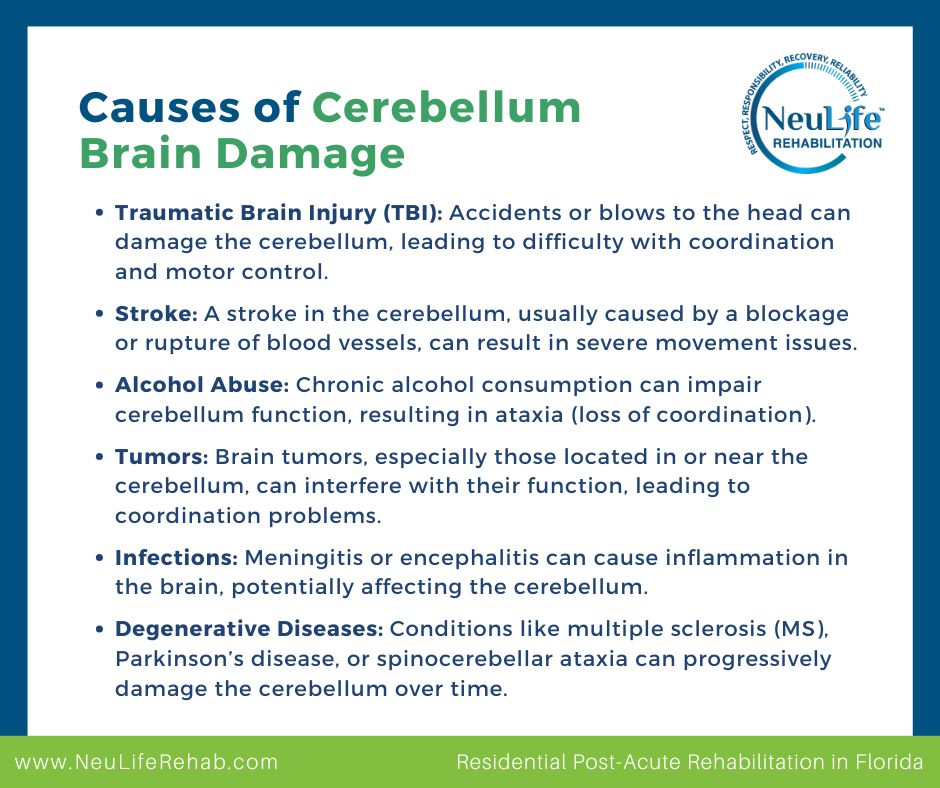
Several factors can lead to damage in the cerebellum, including:
Accidents or blows to the head can damage the cerebellum, leading to difficulty with coordination and motor control.
A stroke in the cerebellum, usually caused by a blockage or rupture of blood vessels, can result in severe movement issues.
Chronic alcohol consumption can impair cerebellum function, resulting in ataxia (loss of coordination).
Brain tumors, especially those located in or near the cerebellum, can interfere with their function, leading to coordination problems.
Meningitis or encephalitis can cause inflammation in the brain, potentially affecting the cerebellum.
Conditions like multiple sclerosis (MS), Parkinson’s disease, or spinocerebellar ataxia can progressively damage the cerebellum over time.
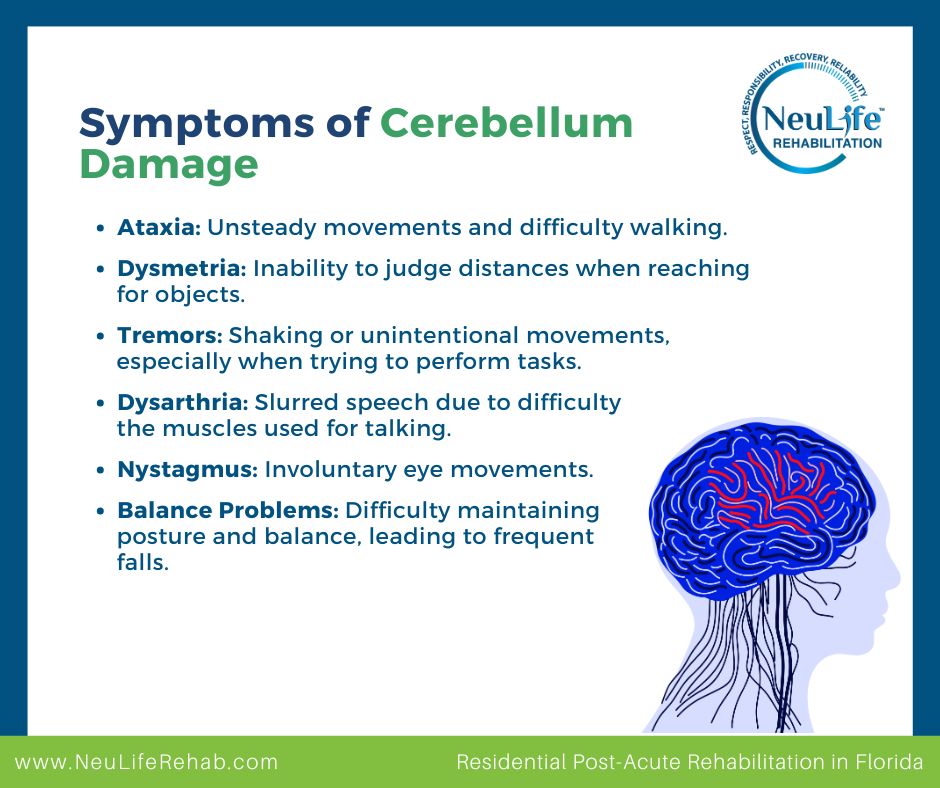
Damage to the cerebellum can result in a variety of symptoms, such as:
Rehabilitation is crucial in assisting individuals with cerebellum damage to recover as much function as possible. A post-acute rehabilitation center like NueLife Rehabilitation focuses on helping patients regain lost abilities and enhance their overall quality of life.
The rehabilitation process typically includes:
Below are key strategies for effectively managing cerebellum damage over the long term.
Recovery from cerebellar brain damage varies depending on the cause, severity, and extent of the damage. Early intervention and consistent rehabilitation efforts are key to improving outcomes and helping individuals regain their independence.
If you or a loved one is facing the challenges of cerebellum brain damage, you don’t have to go through it alone. At NueLife Rehabilitation, we specialize in personalized, evidence-based neuro rehabilitation, including TBI rehabilitation and stroke patient rehab programs designed to restore function, improve mobility, and enhance quality of life.
Want to learn more about the different types of brain damage and how we can help? Explore our blogs on:
Get expert support, compassionate care, and real results. Contact us today to learn how our team can guide you on your path to recovery.
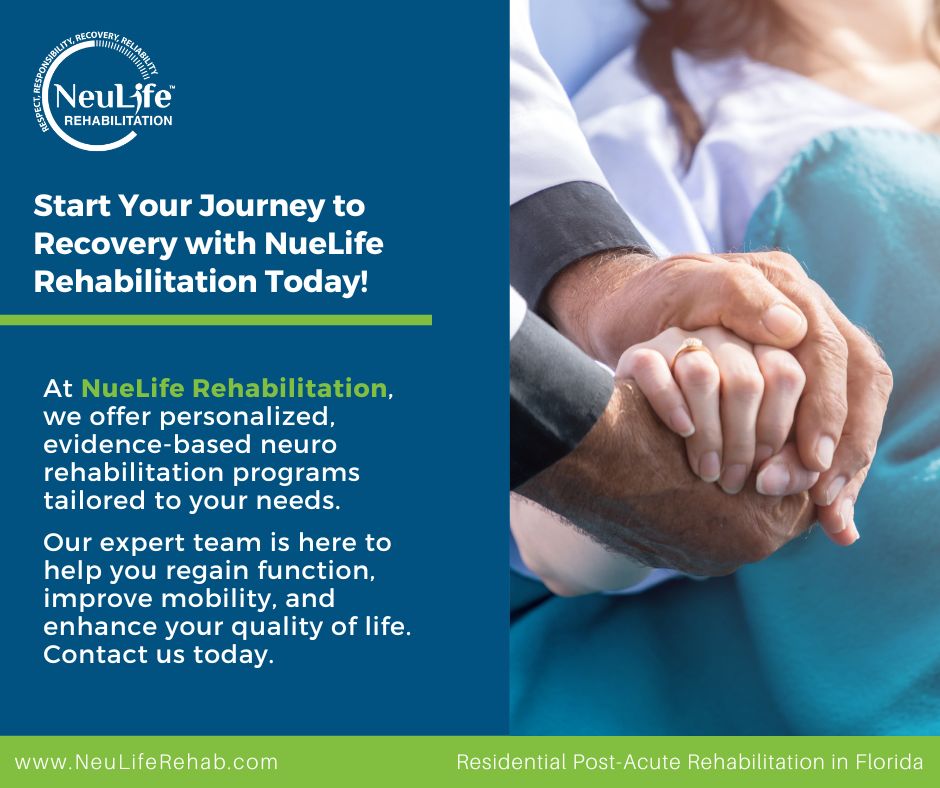
***
The material on this site is for informational purposes only and DOES NOT CONSTITUTE THE PROVIDING OF MEDICAL ADVICE, and is not intended to be a substitute for independent professional medical judgment, advice, diagnosis, or treatment. Always seek the advice of your physician or other qualified healthcare provider with any questions or concerns you may have regarding your health.
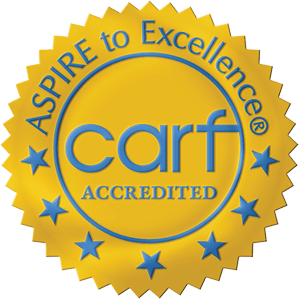
We know that choosing the next step in your recovery from a catastrophic illness or injury is complex. Together, we can help you take the next step.
Contact us with any questions today.